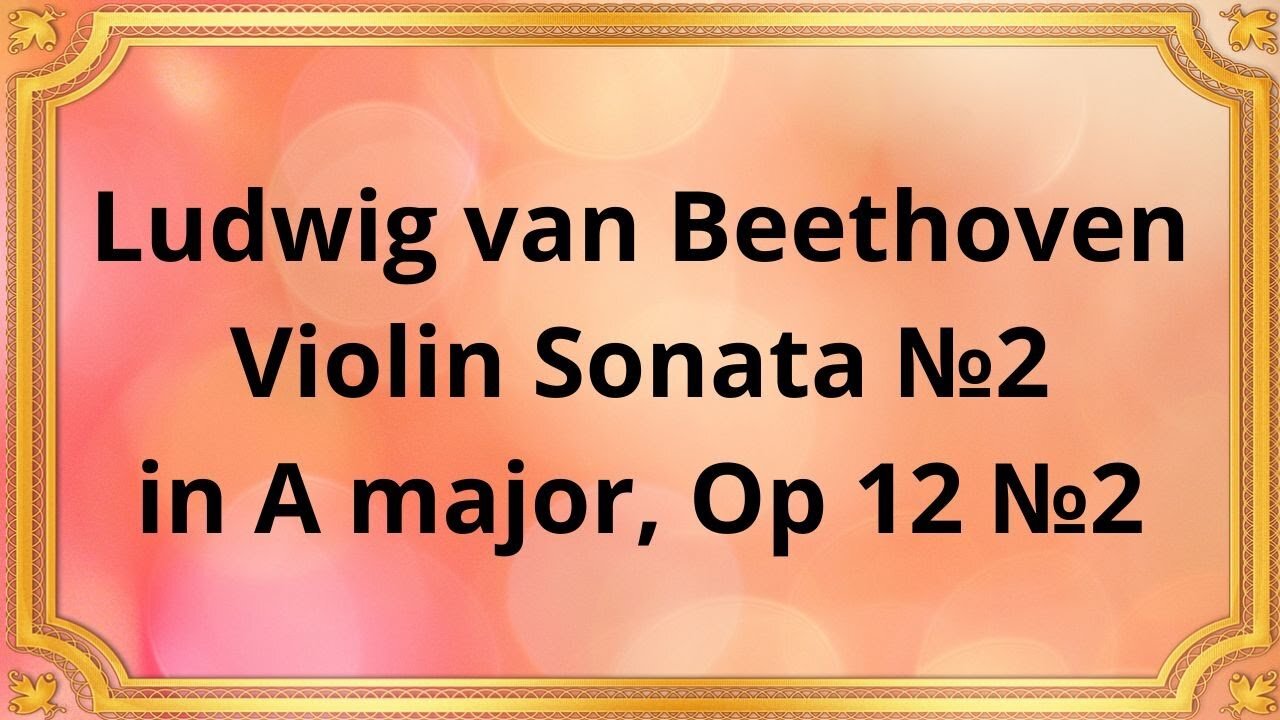Premium Only Content

Ludwig van Beethoven Violin Sonata №2 in A major, Op 12 №2
#Beethoven #ClassicalMusic #ViolinSonata #AMajor #Op12No2 #MusicAppreciation #SonataForm #MusicHistory #Composer #RomanticEra
Wolfgang Schneiderhan, Wilhelm Kempff
Ludwig van Beethoven, one of the most influential composers in history, left an indelible mark on classical music with his revolutionary compositions. Among his vast musical repertoire, the Violin Sonata No. 2 in A Major, Op 12 No. 2, stands as a shining example of his genius.
Beethoven composed the Violin Sonata No. 2 in A Major, Op 12 No. 2, during the late 18th century, a time of transition from the Classical era to the Romantic period. This sonata, written around 1798-1799, showcases Beethoven's departure from the traditional classical style and foreshadows the bold and expressive characteristics that would define his later works.
The Violin Sonata No. 2 follows the traditional three-movement structure commonly found in sonatas of the time. The first movement, marked Allegro vivace, introduces a lively and energetic theme that immediately captivates the listener. The second movement, marked Andante, provides a contrast with its lyrical and introspective character, creating a serene and reflective atmosphere. The final movement, marked Allegro piacevole, brings the sonata to a spirited and joyful conclusion, showcasing Beethoven's mastery of musical expression.
Beethoven's Violin Sonata No. 2 is notable for its innovative and expressive elements. The composition skillfully combines lyricism, virtuosity, and emotional depth, creating a captivating musical experience. Beethoven employs bold dynamic contrasts, sudden shifts in mood, and unexpected harmonic progressions, pushing the boundaries of traditional classical music. These expressive elements allow the performer and the listener to embark on a journey filled with passion, drama, and profound emotions.
The Violin Sonata No. 2 highlights the importance of the collaboration between the violin and piano. Beethoven grants both instruments equal importance, engaging them in a musical conversation throughout the piece. The violin and piano complement each other, intertwining their melodies, harmonies, and rhythms to create a harmonious and balanced musical dialogue.
Beethoven's Violin Sonata No. 2 in A Major, Op 12 No. 2, continues to captivate audiences and musicians alike with its timeless beauty and artistic depth. Its innovative and expressive qualities have made it an essential part of the violin and piano repertoire. This composition showcases Beethoven's remarkable ability to evoke a wide range of emotions, from tender lyricism to exhilarating virtuosity. The Violin Sonata No. 2 stands as a testament to Beethoven's enduring legacy and his profound impact on the evolution of classical music.
Conclusion:
Ludwig van Beethoven's Violin Sonata No. 2 in A Major, Op 12 No. 2, is a testament to the composer's artistic brilliance and his transformative impact on classical music. Its innovative structure, expressive elements, and collaborative nature make it a treasured gem of the violin and piano repertoire. This composition continues to inspire and move audiences, reminding us of Beethoven's unparalleled contributions to the world of music.
You have the opportunity to support the channel:
https://destream.net/live/RadSiarAl/donate
https://www.buymeacoffee.com/6355radsiaral
-
 32:30
32:30
Classical music_Music Inspiration
1 month agoArturo Toscanini Grand Canyon Suite
961 -
 24:53
24:53
Preston Stewart
14 hours ago $3.50 earnedTrump Arms Ukraine
80.5K36 -
 1:00:00
1:00:00
BEK TV
1 day agoDRONES IN AMERICA: DJI'S MARKET DOMINANCE, FUTURE USES, AND A REAL LOOK AT THE MEASLES OUTBREAK
49.3K5 -
 8:22:22
8:22:22
Dr Disrespect
18 hours ago🔴LIVE - DR DISRESPECT - INSANE WARZONE CHALLENGES! DOMINATING 2025 HYPE
200K8 -
 12:55:42
12:55:42
LFA TV
1 day agoLFA TV ALL DAY STREAM - FRIDAY 7/11/25
273K42 -
 1:13:26
1:13:26
Kim Iversen
14 hours agoDershowitz Says He Knows FOR A FACT The Names On The Epstein List
86.3K152 -
 4:18:09
4:18:09
Nerdrotic
14 hours ago $19.27 earnedSuperman's James Gunn DROPS! Comic Book Movies Saved? WOKE Black Superman | Friday Night Tights 362
125K24 -
 42:44
42:44
American Minute with Bill Federer
12 hours ago $4.10 earnedHistory You Need to Know with Dr. Bill Federer
61.7K8 -
 32:52
32:52
Clownfish TV
14 hours agoI Watched SUPERMAN So You Don't Have To...
38.7K17 -
 1:36:33
1:36:33
Roseanne Barr
15 hours ago"The Woman Who Raised Me" | The Roseanne Barr Podcast #106
72.4K49